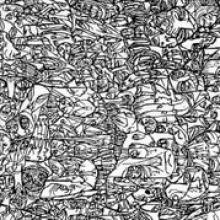What a confusion. Outsider Art seems to be nothing more than a phrase affixed to inaccesible art made by weirdos. The fact that its become something of a buzz word as well as a good way to cash in is a bit detached from the hospitals, nut houses and back roads where the ‘artists’ first crafted works culled from garbage heaps, left over stuffs and whatever traditional art materials were sitting around.
That being said, there is some genuinely cool crazy-person art out there. Whether or not Nick Blinko, front man for Britain’s Rudimentary Peni, counts as one of these fringe peoples is up in the air. He’s well capable of regularly contributing to a band that’s maintained popularity over four decades, but has also done time in a few looney bins. That’s not meant as a criticism – and Blinko, assumedly, doesn’t walk around calling himself an outsider artist – but there needs to be some line drawn as to how people fit into the made up category, and folks should wonder if this guy does.
Regardless of how and where Blinko fits into the art world, though, his band has moved through punk’s past and retains a certain amount of deference even today – and with good reason.
First releasing a few singles during the early ‘80s and eventually working up a long player in ’83, the band continued on through 2008’s No More Pain.Over time the group’s gone through some musical shifts, but never completely detached itself from its noisome punk heritiage. Coming as a part of the second (or third) wave of British punk bands, Rudimentary Peni was lumped into a post-punk category and if not that then was considered anarcho-punk due to its ties to Crass and its recording imprint.
About six years into its recorded legacy, though, the band released an album in 1987 that serves as an homage to everyone’s favorite science fiction writer, H.P. Lovecraft. It might not be immediately apparent, but the lion’s share of Cacophony relates to the novelist and short story writer.
Most aurally recognizabe as kin to the writer is Cacophony’s second track “Horrors in the Museum” which begins as a simple poppy punk track, but soon devolves into whirring noises and feedback. There’re some monster sounds working around in the background, but more notable is the fact that the track is a bit more than three minutes long whereas the remained of the songs here are usually about a minute and some change. It’s a minor aspect of the work to point out, but it then seems that Blinko and Rudimentary Peni were interested in rendering Lovecraft in not just lyrical terms but in sound as well.
“Xenophobia,” much as the afforementioned track, trucks in a good deal of noise while attempting to display some odd distopian place and time where things won’t make complete sense. And then of course, there’s the Freaks reference.
Regardless of the intent of Rudimentary Peni and its album, the result is an interesting malange of punk, rock and (almost) gothy stuffs.
That being said, there is some genuinely cool crazy-person art out there. Whether or not Nick Blinko, front man for Britain’s Rudimentary Peni, counts as one of these fringe peoples is up in the air. He’s well capable of regularly contributing to a band that’s maintained popularity over four decades, but has also done time in a few looney bins. That’s not meant as a criticism – and Blinko, assumedly, doesn’t walk around calling himself an outsider artist – but there needs to be some line drawn as to how people fit into the made up category, and folks should wonder if this guy does.
Regardless of how and where Blinko fits into the art world, though, his band has moved through punk’s past and retains a certain amount of deference even today – and with good reason.
First releasing a few singles during the early ‘80s and eventually working up a long player in ’83, the band continued on through 2008’s No More Pain.Over time the group’s gone through some musical shifts, but never completely detached itself from its noisome punk heritiage. Coming as a part of the second (or third) wave of British punk bands, Rudimentary Peni was lumped into a post-punk category and if not that then was considered anarcho-punk due to its ties to Crass and its recording imprint.
About six years into its recorded legacy, though, the band released an album in 1987 that serves as an homage to everyone’s favorite science fiction writer, H.P. Lovecraft. It might not be immediately apparent, but the lion’s share of Cacophony relates to the novelist and short story writer.
Most aurally recognizabe as kin to the writer is Cacophony’s second track “Horrors in the Museum” which begins as a simple poppy punk track, but soon devolves into whirring noises and feedback. There’re some monster sounds working around in the background, but more notable is the fact that the track is a bit more than three minutes long whereas the remained of the songs here are usually about a minute and some change. It’s a minor aspect of the work to point out, but it then seems that Blinko and Rudimentary Peni were interested in rendering Lovecraft in not just lyrical terms but in sound as well.
“Xenophobia,” much as the afforementioned track, trucks in a good deal of noise while attempting to display some odd distopian place and time where things won’t make complete sense. And then of course, there’s the Freaks reference.
Regardless of the intent of Rudimentary Peni and its album, the result is an interesting malange of punk, rock and (almost) gothy stuffs.
